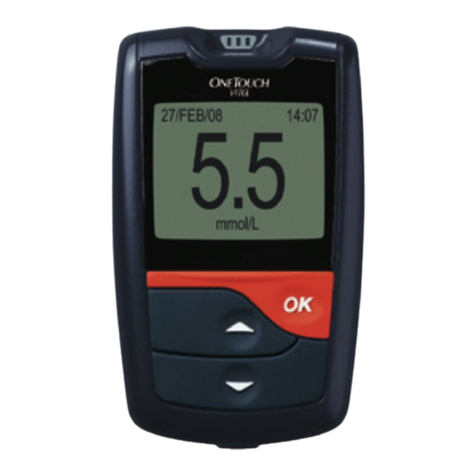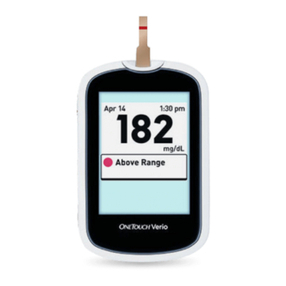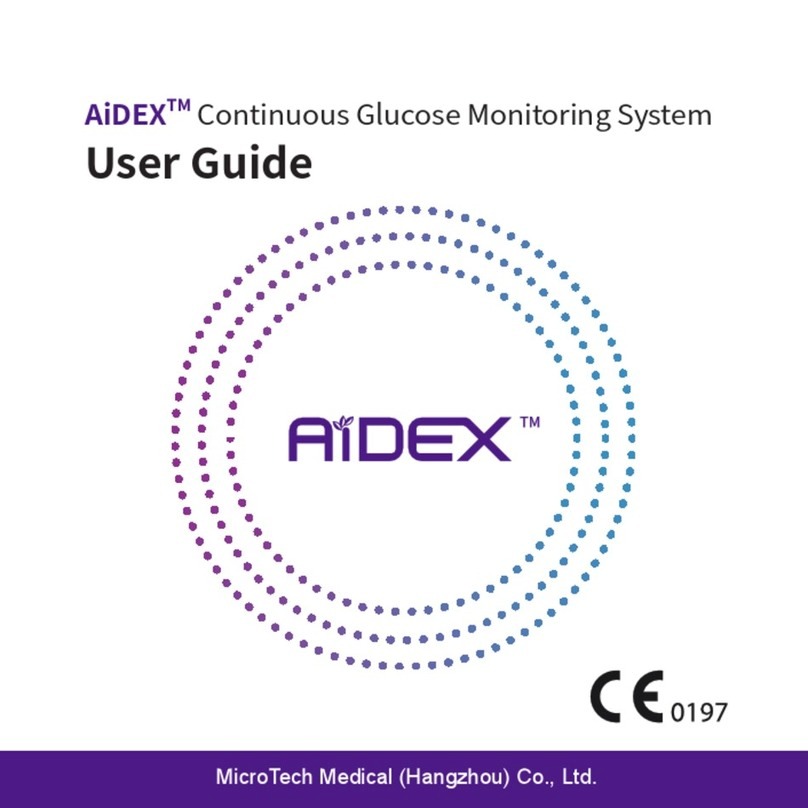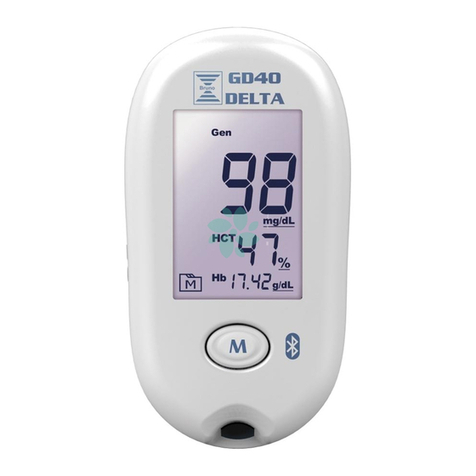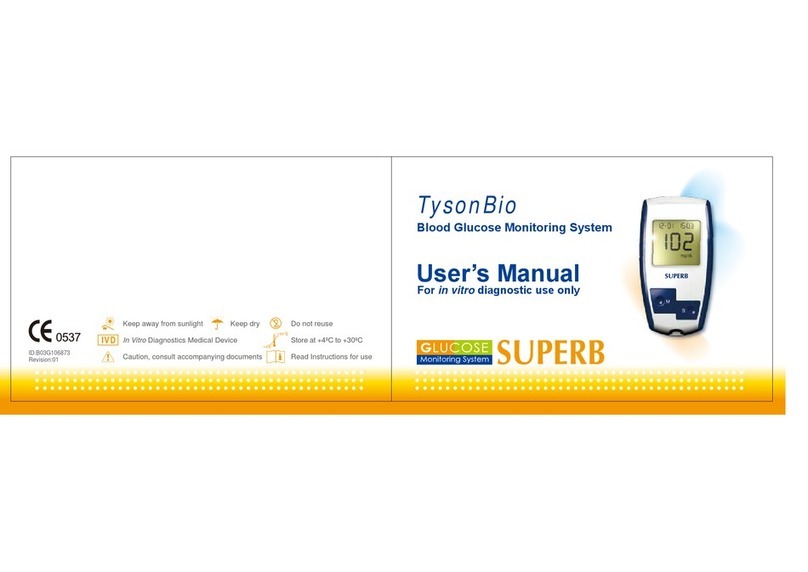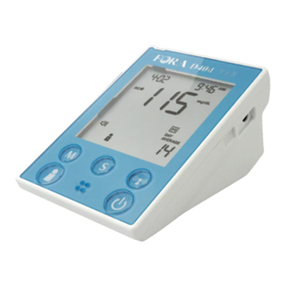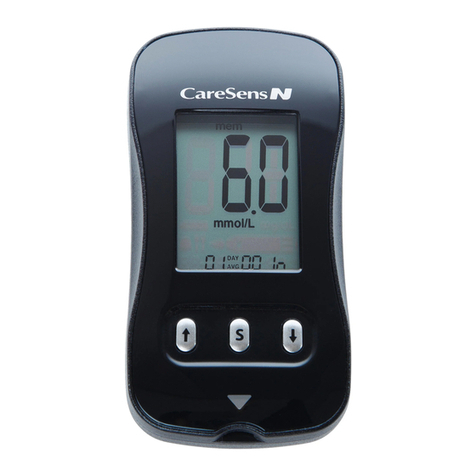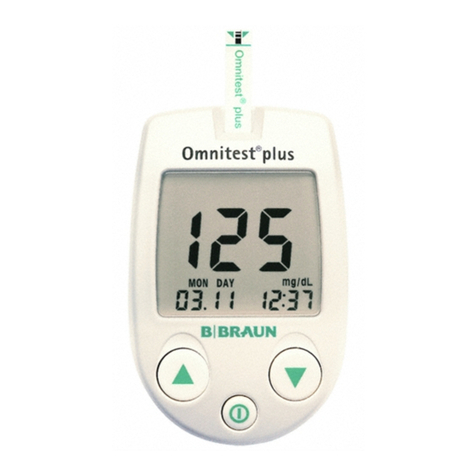SkyMed SURETEST User manual

Owner’s Manual
Ver.05 03/2020
311-4227300-XXX
Blood Glucose
Monitoring System

2
Dear SureTest System Owner:
This manual contains important information you must know about the system.
Please read it thoroughly and carefully.
The greatest feature of this system is its Bilingual Speaking Function,
which is an acoustic aid for users especially with visual disability.
Another unique feature is its No-coding function which means there is no need
to calibrate your meter, and allows you to easily monitor your blood glucose at
home.
The system is intended for use outside the body (in vitro diagnostic use). It
should be used only for testing glucose (sugar) and only with fresh capillary
whole blood samples.The system is intended for use in the home and in clinical
settings. It should not be used for the diagnosis of diabetes or the testing of
newborns.
If you have a question, please contact the Customer Care at 1-888-315-4133 for
assistance.

3
IMPORTANT SAFETY INSTRUCTIONS
PLEASE READ THIS BEFORE USING
The following basic safety precautions should always be taken.
1. Close supervision is necessary when the device is used by, on, or near chil-
dren, or handicapped persons.
2. Use the device only for the intended use described in this manual.
3. Do not use strips and control solutions which are not supplied by
the manufacturer.
4. Do not use the device if it is not working properly, or if it has suffered any
damage.
5. Before using any product to test your blood glucose, read all instructions
thoroughly and practice the test. Do all quality control checks as directed and
consult with a diabetes healthcare professional.
KEEP THESE INSTRUCTIONS
IN A SAFE PLACE

4
TABLE OF CONTENTS
IMPORTANT SAFETY INSTRUCTIONS 03
IMPORTANT INFORMATION 05
ABOUT ALTERNATIVE SITE TESTING (AST) 06
INTRODUCTION OF THE SYSTEM 07
Intended Use 07
Principle of Measurement 07
Contents of the System 08
Appearance and Key Function of the Meter 09
Meter Display Segments 10
Speaking Function 11
Appearance of the Test Strip 12
PREPARATION BEFORE USE 13
Battery Replacement 13
Setting the Meter and Deleting the Memory 14
BEFORE TESTING 18
Checking with SureTest Control Solutions 18
Important Control Solution Information 18
Performing a Control Solution Test 19
TESTING YOUR BLOOD 21
Testing Procedure 22
Expected Test Results 26
COMPARING METER AND LABORATORY RESULTS 26
USING THE METER MEMORY 28
Viewing Results on the Meter 28
Viewing Results on a Personal Computer 30
CARING FOR YOUR METER 31
Cleaning 31
Storage 33
PROBLEM-SOLVING GUIDE 34
Result Indicator 34
Error Message 35
Problem in Operation 35
SPECIFICATIONS 37
WARRANTY/CUSTOMER CARE 38

5
IMPORTANT INFORMATION
• Severe dehydration and extreme uid loss may cause inaccurate results. If you
believe you are suffering from severe dehydration, consult a healthcare
professional immediately.
• Test results below 3.3 mmol/L*1mean low blood glucose (hypoglycemia).Test
results greater than 13.3 mmol/L*2mean high blood glucose (hyperglycemia).
If you get results below 3.3 mmol/L or above 13.3 mmol/L, and do not have
symptoms, rst repeat the test. If you have symptoms or continue to get
results that fall below 3.3 mmol/L or above 13.3 mmol/L, follow the treatment
advice of your healthcare professional.
• Apply only capillary whole blood sample to the self wicking port. Applying
other substances to the self wicking port hole will cause inaccurate results.
• If you are experiencing symptoms that are not consistent with your blood
glucose test results and you have followed all instructions described in this
owner’s manual, call your healthcare professional.
• Inaccurate results may occur in severely hypotensive individuals or patients
in shock. Inaccurate low results may also occur for individuals experiencing
a hyperglycemic-hyperosmolar state, with or without ketosis. Critically ill
patients should not be tested with blood glucose meters.
• Please refer to the test strip package insert for additional important informa-
tion.
*1:Kahn, R., and Weir, G.: Joslinís Diabetes Mellitus, 13th ed. Philadelphia: Lea and Febiger (1994), 489.
*2:Krall, L.P., and Beaser, R.S.: Joslin Diabetes Manual. Philadelphia: Lea and Febiger (1989), 261-263.

6
ABOUT ALTERNATIVE SITE TESTING (AST)
When to use AST?
Food, medication, illness, stress and exercise can affect blood glucose levels.
Capillary blood at ngertip reects these changes faster than capillary blood
at other sites. Alternative site results may be different from ngertip results
when glucose levels are changing rapidly (e.g., after a meal, after taking insulin,
or during or after exercise).Therefore when testing blood glucose during or
immediately after a meal, physical exercise, or after taking insulin, take blood
sample from your nger only.
We strongly recommend you do AST O N LY in the following intervals:
• In a pre-meal or fasting state (more than 2 hours since the last meal).
• Two hours or more after taking insulin.
• Two hours or more after exercise.
Important: There are limitations for doing
AST.
Please consult your healthcare professional
before you do AST.
What is AST?
Alternative site testing (AST) means that
people use parts of the body other than
ngertips to check their blood glucose levels.
This system allows you to test on the palm, the
forearm, and the upper arm with the equivalent
results to ngertip testing.
What’s the advantage?
Fingertips feel pain more readily because they
are full of nerve endings (receptors). At other
body sites, since nerve endings are not so
concentrated, you will not feel as much pain as
at the ngertip.

7
Do NOT use AST if:
• You think your blood glucose is low.
• You are unable to notice symptoms of hypoglycemia.
• Your AST results do not match the way you feel.
• You are testing for hyperglycemia.
• Your routine glucose results are often uctuating.
• You are or may be pregnant.
How to increase the accuracy?
Stimulating blood perfusion by rubbing the puncture site prior to blood
extraction has a signicant inuence on the glucose value obtained. Blood from
the site without rubbing exhibits a measurably different glucose concentration
than blood from the nger. When the puncture site was rubbed prior to blood
extraction, the difference was signicantly reduced.
NOTE: We suggest that you rub the puncture site for about 20 seconds before
taking your sample.
INTRODUCTION OF THE SYSTEM
Intended Use
The system is intended for use outside the body (in vitro diagnostic use). It
should be used only for testing glucose (sugar) and only with fresh capillary
whole blood samples taken from the nger and the alternative sites including the
palm, the forearm, and the upper arm. The system is intended for home use. It
should not be used for the diagnosis of diabetes or for the testing of newborns.
Principle of Measurement
The test is based on the measurement of electrical current generated by
the reaction of glucose with the reagent of the strip. The meter measures the
current and displays the corresponding blood glucose level. The strength of
the current produced by the reaction depends on the amount of glucose in the
blood sample.

8
Contents of the System
The system should be used with three main products: the blood glucose meter,
test strips, and a control solution.These products have been designed, tested,
and proven to work together as a system to produce accurate blood glucose
test results. Use only the SureTest test strips and SureTest control solution with
your SureTest meter.
Your system includes:
1. A meter 2. log book 3. Lancing Device with clear cap
4. Sterile lancets 5. Control solution (Optional) 6. Owner’s manual
7. Carrying case 8.Warranty card
PLEASE NOTE
• Check your system to be sure that it is unopened prior to use and that it
contains all parts listed above. If either of these conditions occurred, please
return your system to the place of purchase.
• Please note that the control solution is optional. It is not included in the stan-
dard kit. Please ask your local agent or call at 1-888-315-4133 for help.
Owner’s manual
log book
(Optional)

9
Appearance and Key Function of the Meter
TEST SLOT
The test slot is where you
insert the test strip for
testing. The meter will turn
on automatically when you
insert a test strip.
DISPLAY
Your test results are
displayed here. The large,
easy-to-read display guides
you through the test using
symbols and simple mes-
sages.
SET BUTTON
(in the back)
Set the date, time and
unit, located in the
battery
compartment.
MAIN BUTTON
The main button in front
of the meter is used to set
up the meter, enter the
memory mode, change the
value of “date time”, unit
setting, memory deletion
and turning the meter on
and off.
DATA PORT
Located at the side, is for cable
connection to the computer.

10
Meter Display Segments
Test Result Area
Test results are displayed here.
Blood Drop Symbol
This symbol tells you when
to apply the sample.
Test Strip Symbol
Appears when the meter is on.
Date
Time
Battery Symbol
Appears when the battery
is low.
Memory Symbol
Appears when you
review the memory.
Temperature Symbol
Appears with ambient
temperature after inserting
a test strip.
CTL Symbol
Appears when performing
a control solution test and
indicates that the result will
not be stored in the memory.
Measurement unit
Appears with the test
result in mmol/L.
Voice Symbol
Indicates speaking function is
on/off.
Day Average
Indicates that the displayed
test result is an average.
Ketone Warning
Appears when the test
result is equal or higher
than 13.3mmoI/L.

11
Speaking Function
When the volume symbol is on the meter, it means that the meter provides
speaking function. It “speaks” step by step and leads you through a blood glucose
test.The following table tells you when and what the meter “speaks”.
WHEN
does the meter say?
WHAT
does the meter speak?
When room temperature is detected. “The room temperature is (number)
degree Celsius.”
When room temperature is outside
operating range.
“Room temperature is out of range,
thus unable to measure.”
When the meter is ready to test.
( “ ”symbol appears on display)
“Please apply blood into the strip.”
When the test is completed.
(The result appears on display).
“Your blood glucose is (number)
Millimole per Liter”
When the test result is outside
measurement range, which is 1.1
to 33.3 mmol/L.
“The blood glucose is out of range,
thus unable to measure.”

12
Appearance of the Test Strip
Your system measures the amount of sugar (glucose) in whole blood. Blood
is applied to the self wicking port of the test strip and is automatically drawn
into the reaction cell where the reaction takes place.
The test strip consists of the following parts:
Contact Bars
Insert this end of the test strip into the meter.
Push it in rmly until it will go no further.
Test Strip Handle
Hold this part to insert the test strip into the slot.
Conrmation Window
This is where you conrm if enough blood
has been applied to the absorbent hole of the strip.
Self Wicking Port
Apply a drop of blood here.
The blood will be drawn automatically.
See pages 21~26,Testing Your Blood, for complete instructions.

13
PREPARATION BEFORE USE
Battery Replacement
Your meter comes with two 1.5V AAA size alkaline batteries.
The meter will alert you when the power is getting low by displaying
two different messages:
1.The symbol appears together with other
display messages: the meter is functional
and the result remains accurate, but it is
time to change the batteries.
2.The symbol appears with the ashing
E-b symbol and “low”: the batteries can not
provide enough power to do a test. You
must change the batteries immediately.
PLEASE NOTE
• Replacing the batteries does not affect the meter’s memory (previous test
results stored in memory). However, the time and date settings may need to
be updated.
• Batteries might leak chemicals if not used for a long time. Remove the batteries
if you are not going to use the device for an extended period (i.e., 3 months or
more).

14
To replace the batteries, make sure that the meter is turned
off.
1. Press the buckle on battery cover and lift up to remove cover.
2. Remove the old batteries and replace with two new 1.5V AAA size alkaline
batteries. Please ensure that batteries are correctly oriented, and rmly seated.
3. Close the battery cover. If the batteries are inserted correctly, you will hear
a “beep”.
1. 2. 3.
WARNING
As with all small batteries, the batteries should be kept away from small children
who still put things in their mouths. If they are swallowed, promptly see a doctor
for help.
Setting the Meter and Deleting the Memory
Year, month, date, time, unit of temperature, memory deletion, speaking volume
and language selection preset. However if you replace the batteries, you may
need to reset the settings of the meter.
Start with the meter off. Then
press the Set button located
in the battery compartment.
The meter is now in the setting
mode. You can start to set up
the meter.

15
STEP 1 Set the Year.
The year will appear rst, with the year
segment ashing. Press and release the
button to advance one year. To move
faster, keep pressing the
button until the desired number
appears. With the correct year on
the display, press the Set button and then
the month segment ashes.
STEP 2 Set the Month
Press and release the button until the
correct month appears. To move faster,
hold the button down. With the
correct month on the display, press the
Set button and then the date segment
ashes.
STEP 3 Set the Date
Press and release the button until
the correct day appears. To move faster,
hold the button down.With the cor-
rect day on the display, press the Set but-
ton and then the hour segment ashes.
STEP 4 Set the Hour
Press and release the button to ad-
vance one hour.To move faster, hold the
button down. With the correct hour
on the display, press the Set button and
then the minute segment ashes.

16
STEP 5 Set the Minutes.
Press and release the button to ad-
vance one minute. To move faster, hold
the button down. With the correct
minute on the display, press the Set
button and then the current unit of
temperature starts ashing.
STEP 6 Delete the Memory
When “dEL” and blinking “ ” symbol is displayed, if you do not want to delete
memory, press the Set button again to skip this step. If you would like to delete
ALL memory, press button, both “dEL” and “ ” will ash. Press the but-
ton again to delete ALL memory.“---”and “ ” are displayed on the meter. The
memory of this meter is empty now.
PLEASE NOTE
• The above settings can ONLY be changed in the setting mode. Therefore,
when you perform a glucose testing, those parameters are not possible to be
changed.
• Your meter displays 7-, 14-, 21-, 28-, 60- and 90-day averages which you can
access from the meter memory.These averages are calculated from results
obtained during the 7-, 14-, 21-, 28-, 60- and 90-day preceding the current date
and time settings.When the date and time are changed, the 7-, 14-, 21-, 28-, 60-
and 90-day averages may change.
• While the meter is in the setting mode, if no button is pressed for 3 minutes,
the meter will turn off automatically.

17
STEP 7 Select Speaking Function
The meter displays “VOL”,“ ” and ashing
number. Press the button to select speaking
volume from 0 to 7.Then press the Set button
to proceed to the next step.
Number 0 indicates that the speaking function
is turned off, where “ ” does not display on
LCD during testing. Number 1 to 7 indicates
speaking volume from low to high, where “ ”
displays on LCD during testing.
STEP 8 Select Languages
L1/L2 and “ ” display on LCD.Your monitor
can speak in one of two languages. Press the
button to select. Select L1 for English, L2 for
French.
The setting model is all completed. Press the Set
button to turn off the meter.“OFF” is displayed
before shut down.The setting is completed.
Congratulations! You have nished setting your meter!

18
BEFORE TESTING
Checking with SureTest Control Solutions
When should the control solution test be performed?
• Whenever you suspect that the meter or test strips are not working properly.
• When your blood glucose test results are not consistent with how you feel, or
when you think your results are not accurate.
• When your test strips are exposed to extreme environmental conditions
(See Storage section of this manual).
• When you want to practice running the test.
• If you drop the meter.
SureTest Control Solutions contain a known amount of glucose that reacts with
test strips. By comparing your control solution test results with the expected
range printed on the test strip vial label, it is able to check that the meter and
the test strips are working together as a system and that you are performing
the test correctly. It is very important that you do this simple check routinely to
make sure you get accurate results.
Important Control Solution Information
• Use only SureTest control solutions.
• Check the expiration date on the control solution vial. Do not use if ex-
pired.
• Control solution, meter, and test strips should come to room temperature
(20-25°C) before testing.
• Shake the vial, discard the rst drop of control solution, and wipe off the
dispenser tip to ensure a good sample and an accurate result.
• Use only for 90 days after rst opening. Record the discard date (date opened
plus 90 days) on the control solution vial. Discard after 90 days.
• Store the control solution tightly closed at temperatures below 30°C.
Do not refrigerate.
PLEASE NOTE
The control solution range printed on the test strip vial is for SureTest control
solution only. It is used to test meter and test strip performance. It is not the
recommended range for your blood glucose level.

19
Performing a Control Solution Test
STEP 1 Insert the Test Strip
Insert a test strip with contact bars end rst
and facing up, into the test slot.The meter
turns on automatically and displays the
followings in sequence:
“CH” and “ ” ambient temperature
date, time and ashing “ ”
• Contact bars must be inserted all the way into the meter or you may get an
inaccurate test result.
• Every time you perform a control solution test, you must enter into the “CTL”
test mode so that the test result will not be stored in the meter memory.
Failure to do so will confuse the blood glucose test result with the control
solution test result in memory.
WARNING
STEP 3 Obtain Control Solution.
Shake the control solution vial thoroughly before use. Squeeze out a drop and
wipe it off, then squeeze out another drop and place it on the tip of the vial cap.
STEP 2 Press the button
While the “ ” symbol appears on
the display, press the button and
then “CTL” will appear on the display.
With the “CTL” sign on the display, the
meter will not store your test result in
memory. If you decide not to perform
a control solution test, press the
button again, and the “CTL” sign will
disappear.

20
STEP 4 Apply Control Solution.
Hold the meter to move the self wicking port
of the test strip to touch the drop. Once the
conrmation window lls completely, the
meter will begin counting down.To avoid
contaminating the control solution, do not
directly apply control solution onto a strip.
To avoid contaminating the control solution
with the content of the test strip, you have
to place a drop of control solution on a clean
surface or on your nger tip rst. Then touch
the test strip to the drop.
STEP 5 Read and Compare the Result
After counting to 0, the test result of control
solution is shown on the screen. Compare this
result with the range printed on the test strip
vial. It should fall within this range.
Out-of-range results
If test results fall outside the range printed on the test strip vial, check the
section of “Problem in Operation” in troubleshooting guide and repeat
the test. If you continue to get out-of-range results, it means that the system
may not be working properly. Do NOT test your blood. Contact your local
Customer Care Line at 1-888-315-4133 for help.
6.0-9.1
Normal
Table of contents
Other SkyMed Blood Glucose Meter manuals
Popular Blood Glucose Meter manuals by other brands
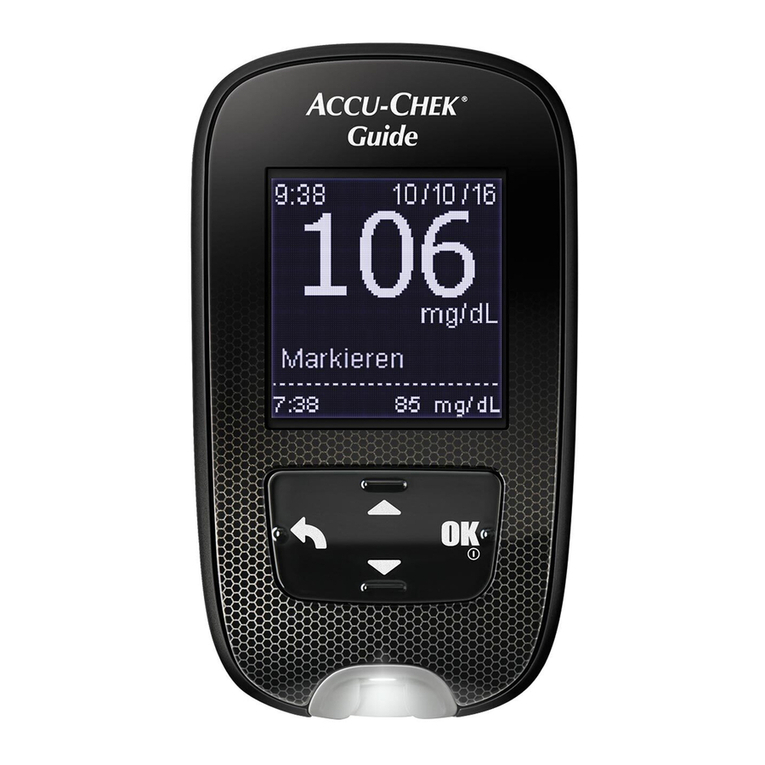
Accu-Chek
Accu-Chek Guide user manual
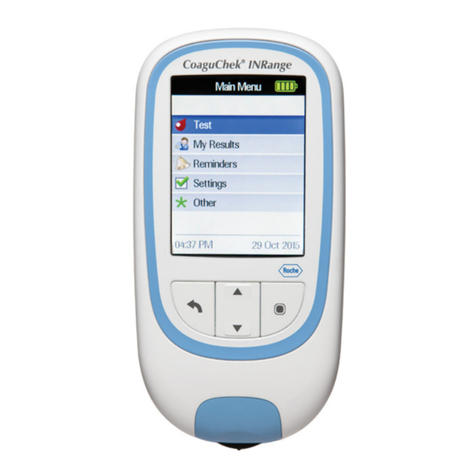
Tunstall
Tunstall Roche CoaguChek XS System quick start guide
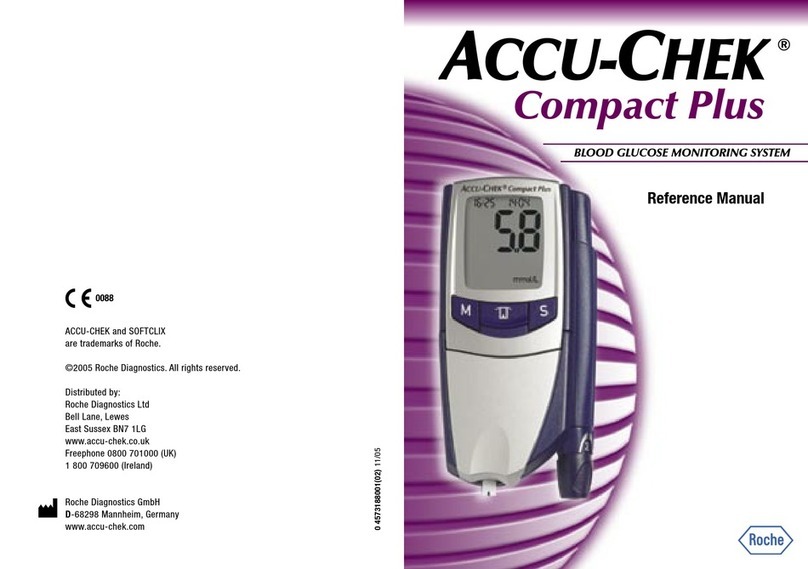
Accu-Chek
Accu-Chek Compact Plus Reference manual
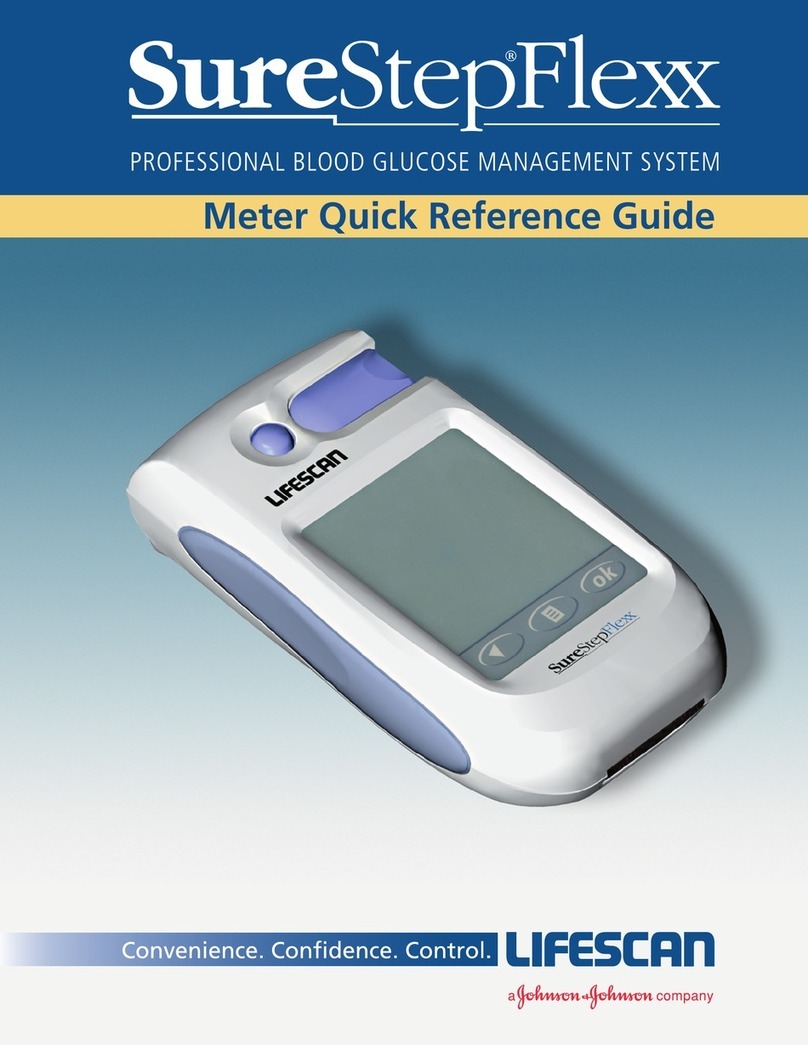
Lifescan
Lifescan Sure Step Flexx Quick refence guide

Lifescan
Lifescan OneTouch UltraMini Blood Glucose Modelling... Procedure guide

gluco-comfort
gluco-comfort BGM 105 operating manual


